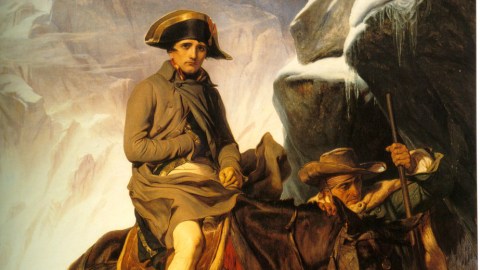Napoleon’s Major Wardrobe Malfunction: An Introduction to Science XPlained

200 years ago today, Napoleon’s army fought the Russians in the Battle of Maloyaroslavets, one of the bloody battles that followed Napoleon’s evacuation of Moscow. While this battle may have been a French victory, it turned out to be a major strategic setback, as the Russians were able to block Napoleon’s preferred path of retreat in his long march out of Russia.
Napoleon shifted his forces north over land that had been devastated by both the previous French advance and by Russia’s scorched-earth policies. Only 10,000 men made it out of Russia out of an initial Grande Armée force of over half a million.
Two centuries later, historians are still debating the exact cause of this military catastrophe.
In the video below, Ainissa Ramirez, a materials scientist at Yale University, entertains the idea that chemistry, not generalship, may have played the decisive role in Napoleon’s defeat. As Ramirez points out, the bonding structure of tin atoms starts to change when temperatures drop below 56°F (13.2°C), and this process speeds up as the temperature decreases. Tin was the main metal used to make the buttons of French uniforms. As the temperature approached -30°C, the tin buttons may have turned to dust.
In other words, the harsh Russian winter, combined with the chemical properties of tin, may have led to “the greatest wardrobe malfunction in history.”
Watch the video here:
What’s the Significance?
Due to its immense historical significance, Napoleon’s Russian campaign has served as a springboard for literary and scientific inquiries alike. This event was also the subject of perhaps the greatest flow chart ever made. That was produced by Charles Joseph Minard, the French civil engineer and pioneer in information graphics.
Minard’s chart. A larger version can be found here.
Minard’s flow chart displays several variables, such as the size of the Napoleon’s forces, the geographical coordinates, as well as the temperature along the path of the retreat. We can vividly see how the army melts away as the Russian winter sets in. In this sense, Minard’s famous chart has been said to defy “the pen of the historian in its brutal eloquence.”
Similarly, our understanding of materials science can help to enhance our understanding of history, or even change our interpretation of events altogether. As Ramirez points out, materials “are not static objects.” Tin, after all, is extremely important in our world today, as it is a major component of solder that is used to hold together electronic equipment. Due to its high value, Ramirez points out, tin has become the source of many conflicts around the world, and it has obtained the unusual designation as a “conflict material.”
Yale associate professor Ainissa Ramirez is a material scientist who wants to share her love for science. This is her last year in the academic world, but she’ll still be teaching in her new career as a “science popularizer.”
Armed with a passion for materials science and a gift for explaining scientific concepts in lay terms that do not dumb down the principles at work, Ramirez is developing a series of short videos that we are thrilled to be presenting on Big Think. The videos take a science lens to topics in the news. Ramirez told us, “I have been an advocate of science education for over a decade, so I started this series to get a broader reach.” The videos can also be viewed at Science Xplained, and on Youtube.
Ramirez’s career change is a natural extension of other things she’s been doing. In 2004 she started Science Saturdays, a family oriented program that brings the excitement of research and the passion of scientists to school-age children in New Haven. Lectures are on topics like “Genetic Anthropology: Finding Human History in Spit,” and “How to See a Black Hole.”
Stay tuned to Big Think for more.





